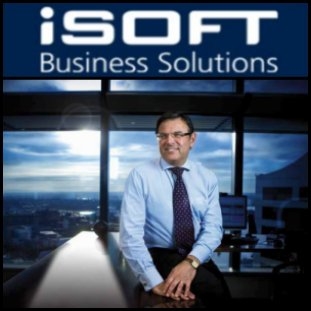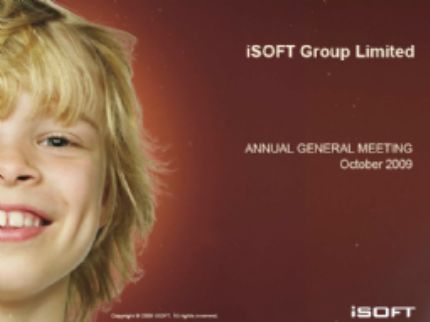
iSOFT Group Limited (ASX:ISF) Interview With CEO Mr Gary Cohen On Sustainable Growth
Sydney, Aug 26, 2009 AEST (ABN Newswire) - iSOFT Group Limited (ASX:ISF) last week reported underlying net profit (excluding intangible amortisation on acquisition) of A$66.0 million, up from A$32.9 million in the previous year. Underlying EBITDA was A$132.4 million, up from A$96.4 million on sales revenue of A$538.9 million, up from A$358.0 million. In the second half EBITDA was A$63.9 million, down 11 percent from the previous corresponding period. How indicative is the second half performance of the earnings outlook for the current year ending June 2010?
Executive Chairman & CEO Gary Cohen
In the first half of the 2009 financial year two matters affected the result. The first was exchange rates, which boosted the translation into Australian dollars of the pound and euro, our major revenue currencies. We don't expect to see a similar swing again this year. The second was the re-phasing of our UK contract with CSC, which meant that about A$10 million of license fees that were accrued in the first half had to be reversed in the second half.
In 2010 we're therefore expecting the second half to be materially stronger than the first half in terms of earnings, and for operating cash flow to trend in a similar manner to 2009.
corporate file
At constant currency, calculated at 30 June 2009, revenue was A$503.2 million, well below your guidance of A$540 million to A$560 million. EBITDA at constant currency was A$121.9 million, at the low end of your guidance of A$120 million to A$130 million. This suggests underlying performance was weaker than expected and that there was a considerable currency benefit in 2009. Can you comment?
Executive Chairman & CEO Gary Cohen
The guidance was not given or tracked on a constant currency basis. We've tried to show how the underlying operations performed year on year by providing the numbers at the exchange rates at 30 June 2009. The exchange rate used at the time of guidance would have resulted in a higher profit.
corporate file
Your forecast of 10 percent revenue growth in the current year seems conservative given previous expectations of revenue growth of around 20 percent. Can you comment?
Executive Chairman & CEO Gary Cohen
If you assume revenue for 2009 derived at the closing currency rate, the true starting point would be a revenue run rate of about A$503 million, as our constant currency analysis suggests. On that basis, our expected revenue growth would be 18 percent, which we think is quite a good growth target compared with our peers.
Our forecast only contains those items that are already in the backlog and the pipeline that we're confident of forecasting. Around 64 percent of our forecast revenues are recurring or were contracted, including our backlog, at the beginning of 2010. This figure has stayed relatively constant over the years and reflects the dynamics of our business where customers are typically "sticky" and new or renewed contracts have lead times of several months or even years.
The forecast doesn't contain large upcoming contracts that we reasonably expect to be in the running for, along with our rivals. These "bluebirds" are almost impossible to predict. It also doesn't factor in the very large potential opportunities resulting from the changes we're seeing in the UK National Programme for IT (NPfIT) or the potential of an electronic health record in the Australian market. Neither does it contain any of the potential upside from our new Viaduct or Health Studio solutions in the US market, which we only recently entered following our acquisition of BridgeForward.
corporate file
EBITDA margin was 24.6 percent in 2009, down from 26.9 percent but better than guidance of 23 percent. What will be the main drivers of margin going forward?
Executive Chairman & CEO Gary Cohen
Our margin in 2009 was better than expected because we were able to curtail costs. We've continued to invest in sales and marketing, infrastructure and, of course, our product. Our long-term guidance is for margins to improve as our corporate and development costs grow at a slower rate than our revenues and the benefits of these investment initiatives come through.
corporate file
iSOFT spent A$96.1 million on R&D in 2009, equivalent to 17.8 percent of revenue, up from A$46.7 million, equivalent to 13.0 percent of revenue, in 2008.
Of the total R&D spend in 2009, A$18.0 million was capitalised. What do the capitalised costs relate to and what is the expected amortisation time-frame?
Will you need to maintain R&D spending at this proportion of revenue in future?
Executive Chairman & CEO Gary Cohen
We're a software developer first and foremost, which means that investing in innovation is our lifeblood. R&D will always be significant. Comparisons with 2008 are not valid as that year contained only eight months of the UK acquisition. We expect R&D in 2010 to be just over 20 percent of revenue, a bit higher than 2009. Our development costs for Lorenzo, in particular, will drop as the NPfIT draws to a close and sales of the new Lorenzo solution kick in. As a proportion of revenue, our R&D expense is expected to pull back closer to the industry average of about 15 percent.
At the moment a significant portion of our R&D - some 78 percent - is expensed because that proportion relates to the Lorenzo Regional Care solution, the development costs of which we recover under the NPfiT programme.
The capitalised remainder related to investment in the innovation cycle of all our core products, including Lorenzo (not Lorenzo Regional Care, which is the UK version) and Health Studio. It's interesting to note that notwithstanding our heavy investment in new products, the capitalised percentage of our R&D is comparable to our peers.
corporate file
The majority of iSOFT's EBITDA growth was attributable to the UK-Ireland and continental Europe markets, which accounted for 65.5 and 21.0 percent respectively of total EBITDA. What were the drivers of EBITDA growth in these markets? To what extent did the UK growth reflect earnings from the NPfIT? How sustainable is the growth in these markets?
Executive Chairman & CEO Gary Cohen
We earned GBP58 million in revenue from the NPfIT in 2009 compared with GBP47 million, on an annualised basis, in the prior year. This represents about half our UK and Ireland business. The remainder consists of our core existing, or non-Lorenzo products, which enjoy a market share of about 60 percent. In Ireland and Northern Ireland we're the national supplier. In the UK, our major opportunity lies in using our market leading position to leverage the changes that are occurring in the NPfIT.
In 2009 we restructured the UK business and strengthened its management team. We expect to see more efficiencies come through from further restructuring of the organisation in the current year. We'll also continue to focus on building up our sales and marketing: under its previous ownership the company had become too reliant on the NPfIT rather than building its own sales teams.
We also see significant opportunity in the south of the UK, which is opening up for direct competition from vendors. We have a significant market share in the south, with over 50 percent of National Health Scheme (NHS) hospital trusts using some form of iSOFT solution. The benefits of being able to compete in the market have already started to show through with Heatherwood and Wexham NHS signing up to upgrades of existing iSOFT solutions as well as Lorenzo.
Continental Europe showed strong growth in 2009 and we see considerable potential in these markets in 2010.
corporate file
The UK opposition Tory party, which is widely seen as the likely winner of any nearer term election, has recently proposed possible changes to the NPfIT which would see the Local Service Providers, such as CSC, taking a lesser role.
What would happen to your earnings and margins if the UK's health IT market were opened to competition? What is your competitive position in the UK market?
Executive Chairman & CEO Gary Cohen
As we're the leading provider of health IT solutions in England with a 60 percent market share, the proposed changes, should they occur, could open up a number of unexpected, but significant opportunities for us. The model being pushed in the south could potentially be used in other regions including London - where we also enjoy a significant market share. This would mean that the hospital trusts could opt out of the current Local Service Provider arrangement and deal directly with application providers like us.
The key positive for us would be that we'd be able to deal directly with our customers in the UK, where we already have the leading market share.
corporate file
Net operating cash flow was A$64.3 million in 2009, down from A$76.2 million in the previous year, reflecting an increase in working capital, with payables down substantially. What ability do you have to control working capital flows in the current environment and how might cash flows trend as you move into the implementation phase of UK NPfIT?
Executive Chairman & CEO Gary Cohen
Our operating cash flows were affected in 2009 by two one-off items totalling A$25 million that were carry-overs from the UK acquisition. Underlying operating cash flow was A$89.3 million, which represents about 67 percent of our EBITDA. This number also compares favourably with the cash conversion percentage of our peers which ranges from 50 to 70 percent. Our business is seasonal, and we expect operating cash flow in 2010 to trend in a similar way to 2009.
corporate file
Net debt was A$156.4 million as at the end of June, down from A$275.2 million a year earlier, reflecting your A$116 million rights issue in March. Net debt to equity was 21.1 percent, down from 47.8 percent. To what extent do you now have a "lazy" balance sheet? Do you have adequate balance sheet capacity to support your growth ambitions for the business?
Executive Chairman & CEO Gary Cohen
We intend to maintain conservative gearing levels, having significantly cut our debt levels in the past few months via the capital raising. We'll look to reduce our debt further and still need to retire the balance of the contract financing of A$38 million we inherited with the UK acquisition.
We've recently made two small acquisitions, and there are considerable opportunities for more bolt-on acquisitions as the global health IT industry gathers momentum and moves out of the embryonic phase.
Going forward, our primary focus is on strengthening our footprint in our core European markets. We see bolt-on acquisitions, but don't foresee making a sizeable acquisition in the near term.
corporate file
iSOFT has reinstated dividend payments, with a final dividend of 1 cents per share. This equates to a payout ratio of 23 percent of reported earnings and 12 percent of underlying earnings. What will be your payout policy going forward and how will seek to balance funding the growth of the business against returning funds to shareholders?
Executive Chairman & CEO Gary Cohen
We intend to pay out up to 20 percent of our normalised earnings as a dividend.
Contact
Gary Cohen
Executive Chairman & CEO
iSOFT Group Limited
Tel: +61-2-8251-6700
Email: gary.cohen@isofthealth.com
Stuart Kelly
Director, Corporate Affairs
iSOFT Group Limited
Tel: +61-2-8251-6769
Mob: +61-404-082-361
Email: stuart.kelly@isofthealth.com
| ||
|




